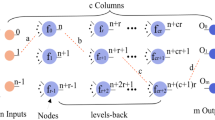Abstract
The genetic algorithm-backpropagation neural network algorithm (GA-BP) makes full use of the advantages of genetic algorithm (GA) and BP neural network (BPNN). It has been widely used in practical problems, but it also has shortcomings such as slow convergence. Inspired by the generative adversarial network, a population competition mechanism (PCM) is proposed to improve the search ability of the GA, two populations are generated to compete, and the winning population can obtain the optimal individual from the failed population to ensure that the winning population has a sustainable advantage. The failed population will randomly generate new individuals and add new genes so as to get better individuals, through such a mechanism to ensure the rapid optimization of the entire population, avoid the risk of premature convergence, speed up the iterative speed and improve the stability of the GA. According to the characteristics of the fitness landscape, the learning rate of the BPNN is optimized, and it can change adaptively, which can effectively improve the network convergence speed and greatly reduce the time cost. We define the GA-BP that improves the learning rate based on fitness landscape as FL-GA-BP algorithm. On the basis of the FL-GA-BP algorithm, adding GA improved with PCM, we define this new algorithm as I-GA-BP algorithm, namely the I-GA-BP algorithm that combines PCM-improved GA and fitness landscape-improved BPNN. In this paper, we use two types of test functions with different characteristics and complexity to conduct experiments to verify the effectiveness of the I-GA-BP algorithm. By comparing the experimental data of the three algorithms GA-BP, FL-GA-BP and I-GA-BP, it is obtained that the I-GA-BP algorithm can better escape from the local optimal solution, which is more conducive to finding the global optimal solution. It also greatly improves the convergence speed of the neural network. Finally, we briefly discussed the effect of adjusting the number of neurons on the stability of the I-GA-BP algorithm.





























Similar content being viewed by others
Availability of data and material
The data sets used and analyzed during the current study are available from the corresponding author on reasonable request.
References
Albayrak M, Allahverdi N (2011) Development a new mutation operator to solve the traveling salesman problem by aid of genetic algorithms. Expert Syst Appl 38(3):1313–1320
Boulmane A, Zidani Y, Belkhayat D, Bouchouirbat M (2020) A GA-based adaptive mechanism for sensorless vector control of induction motor drives for urban electric vehicles. Turkish J Electr Eng Computer Sci 28(3):1731–1746
Ding C, Chen L, Zhong B (2018) Exploration of intelligent computing based on improved hybrid genetic algorithm. Cluster Comput 22:9037
Fragata I et al (2019) Evolution in the light of fitness landscape theory. Trends Ecol Evol 34(1):69–82
Goodfellow IJ et al (2014) Generative adversarial networks. Adv Neural Inf Process Syst 3:2672–2680
Hao J, Haoran R, Wenhong J (2017) BP neural network stock price forecast based on adaptive genetic algorithm optimization. Henan Sci 35(02):190–195
Hecht-Nielsen R (1989) Theory of the backpropagation neural network. [C] neural networks, 1989. In: IJCNN, international joint conference on
Jennings PC, Lysgaard S, Hummelshøj JS et al (2019) Genetic algorithms for computational materials discovery accelerated by machine learning. Npj Comput Mater 5(1):1–6
Jiang L, Zhang X-x (2018) BP neural network optimization by adaptive differential genetic algorithm. Softw Guide 17(11):26–29
LI EY, Yang PX, Sun XB (2008) Improved algorithm of BP neural networks based on the activation function with four adjustable parameters. Microelectron Computer 25(11):89–93
Ponnambalam SG, Jawahar N, Kumar B (2002) Estimation of optimum genetic control parameters for job shop scheduling. International J Adv Manuf Technol 19(3):224–234
Surjanovic S, Bingham D (2013) Virtual library of simulation experiments: test functions and datasets. Retrieved March 24, 2019, from http://www.sfu.ca/~ssurjano
Tang KZ, Sun TK, Yang JY (2011) An improved genetic algorithm based on a novel selection strategy for nonlinear programming problems. Comput Chem Eng 35(4):615–621
Tutkun N (2009) Optimization of multimodal continuous functions using a new crossover for the real-coded genetic algorithms. Expert Syst Appl 36(4):8172–8177
Wang F (2018) Research on application of big data in internet financial credit investigation based on improved GA-BP neural network. Complexity 2018:1–16
Wang L, Tang D (2011) An improved adaptive genetic algorithm based on hormone modulation mechanism for job-shop scheduling problem. Expert Syst Appl 38(6):7243–7250
Wang G, Chen Y, Li QF, Lu C, Chen G, Huang LX (2019) Ultrasonic computerized tomography imaging method with combinatorial optimization algorithm for concrete pile foundation. IEEE Access 7:132395–132405
Wei H, Tang XS, Liu H (2015) A genetic algorithm (GA) based method for the combinatorial optimization in contour formation. Appl Intell 43(1):112–131
Zhang Y (2019) Application of improved BP neural network based on e-commerce supply chain network data in the forecast of aquatic product export volume. Cogn Syst Res 57:228–235
Zang D, Wang K (2015) A genetic algorithm mixing local search algorithm for solving travelling salesman problem. Computer Appl Softw 32(03):266–270
Acknowledgements
Not applicable.
Author information
Authors and Affiliations
Contributions
JY, YH and YW carried out the improved method of this paper. JY and YH conducted data experiments. JY and KZ were major contributors in writing the manuscript. All authors read and approved the final manuscript.
Corresponding author
Ethics declarations
Conflict of interest
The authors declare that they have no competing interests.
Human and animal rights
The research did not involve human participants and/or animals.
Additional information
Communicated by V. Loia.
Publisher's Note
Springer Nature remains neutral with regard to jurisdictional claims in published maps and institutional affiliations.
Rights and permissions
About this article
Cite this article
Yang, J., Hu, Y., Zhang, K. et al. An improved evolution algorithm using population competition genetic algorithm and self-correction BP neural network based on fitness landscape. Soft Comput 25, 1751–1776 (2021). https://doi.org/10.1007/s00500-020-05250-7
Published:
Issue Date:
DOI: https://doi.org/10.1007/s00500-020-05250-7




